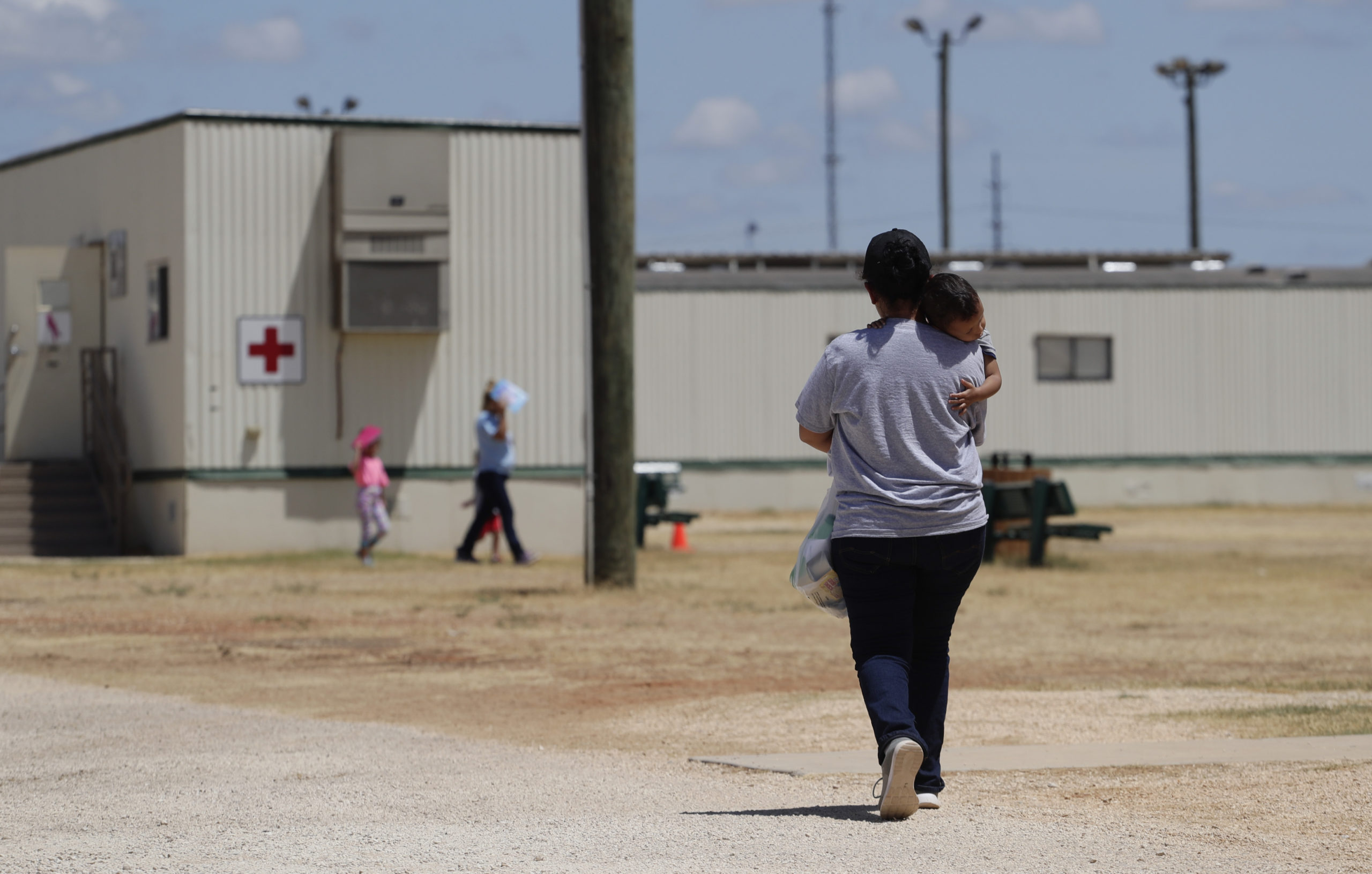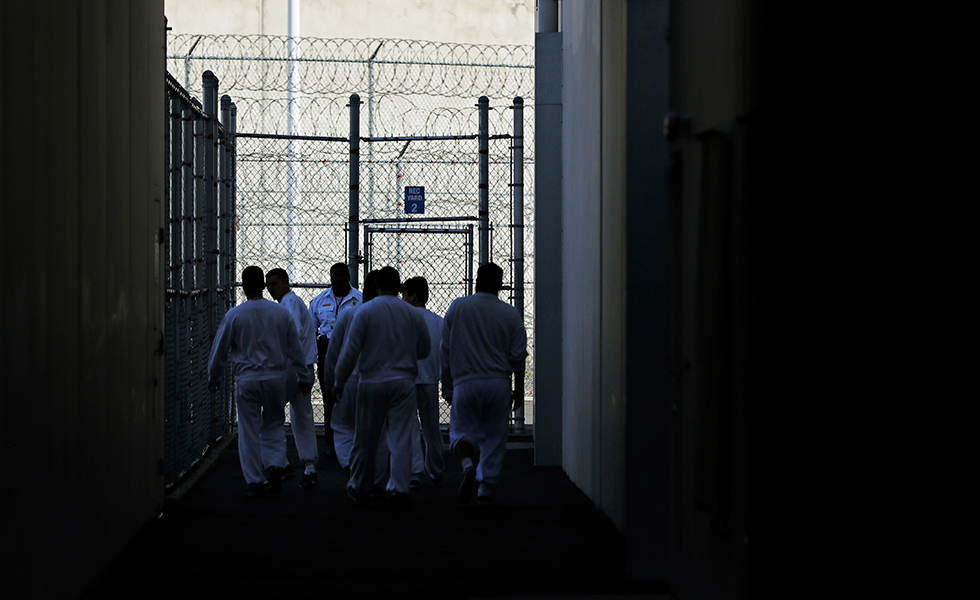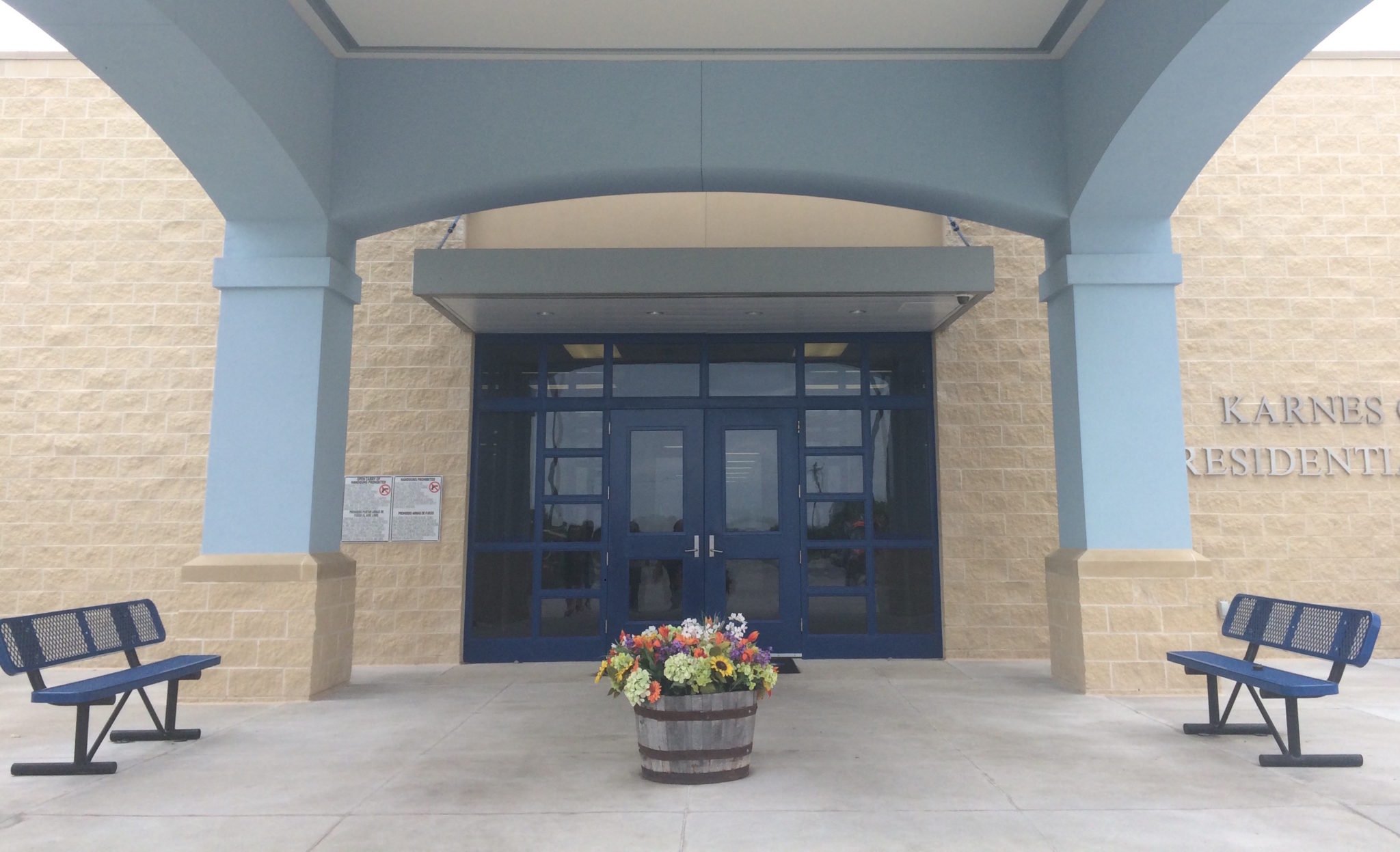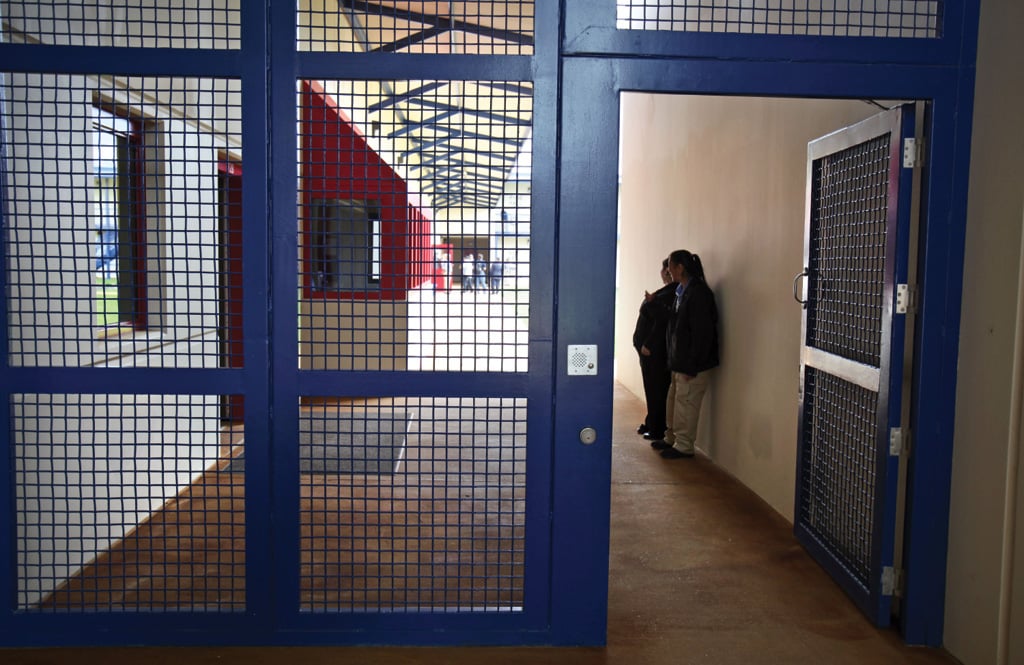
Seeking Asylum in Karnes City
An up-close-and-personal view of family detention in a for-profit lock-up in South Texas.
A version of this story ran in the February 2015 issue.
To get to Karnes City, we drove through a town that smells of smoking beef and a town that smells of oil. We passed muddy cotton fields, four Dairy Queens and rusted pumpjacks that bobbed against the horizon like hungry birds. In Luling, they’ve decorated those pumps—one as a family of ducklings, another as a high school quarterback hurling a football. Approaching Karnes City, we passed eternal-seeming flames spouting from far-off drilling rigs and trailer parks that house the people who work on those fracking sites.
We were headed to an outpost of another big Texas industry—the Karnes County Residential Center, a civil detention center run by the private prison corporation GEO Group Inc. This is where U.S. Immigration and Customs Enforcement (ICE) keeps women and children who have come to the United States without permission. Most of the women at Karnes are asylum seekers from Central America. That means they fled their homes because of something horrible that happened to them or their children. They’ve been raped, beaten, harassed, or had their lives threatened by husbands or boyfriends or gang members, and they are asking the U.S. government for help.
Virginia Raymond, the immigration lawyer I work with as a paralegal, makes the two-hour drive from Austin to visit clients here once or twice a week. I’d come along this time, in November, to help with interviews and to share the driving. Most of the time I see clients in our office. I interview them, help with their immigration applications, and sometimes drive long distances to file court papers. This was my first visit to Karnes.
Growing up, I always heard that immigrants came to this country “in search of better lives,” for “more opportunities.” They wanted to make money and to educate their kids, I was told. But the people in Karnes are scared. They’re running from something.
We’d driven to Karnes because a family we represent—Reza and her daughters, Julie and Dalia (not their real names)—was scheduled to be released that night. Though a judge had set their bond impossibly high—impossible, that is, for an impoverished Honduran woman—we’d cobbled together the funds from individual donations and the San Antonio-based Refugee and Immigrant Center for Education and Legal Services. An $8,000 money order had been deposited at an ICE office in San Antonio that morning. Now it was 3 p.m.; if everything went smoothly, Reza, Julie and Dalia would be free by nightfall.
The imminent release felt like a small miracle. The asylum officer who first questioned Reza in her “credible fear” interview determined that she did not have a legitimate fear of persecution in Honduras, but after hearing her story a judge reversed the officer’s findings. This surprised everyone. Virginia was sitting with Reza in Karnes when the judge issued his decision from the screen. She says even some of the prison staff cried.
“I am troubled by your case,” the judge had told Reza. “I don’t know how to rule, and so I think you deserve to go through the full asylum application process.” Virginia said it was one of the more humble decisions she’d seen from an immigration judge, many of whom rarely reverse negative credible-fear findings, and some of whom deny every asylum claim they hear. The ruling allowed Reza to request her release on bond. Once released, she’d still pursue her asylum claim—she just wouldn’t be locked up during the process. People leave Karnes for a number of reasons. ICE might release them on bond or grant them parole. Some receive asylum. Others are transferred to other facilities. But for every five people released from Karnes, one gets deported by bus or by plane.
This is a thought that sticks with me: What must those flights be like for these once-hopeful immigrants, the grittiest and bravest, and also the most desperate, poor and terrified, their hopes now dashed? Many, I imagine, would be taking a plane for the first time. The engines would bellow around them, and they’d feel the wheels lift into the air while their stomachs stayed on the ground. To get here they’d have walked, ridden on the roofs of trains, crammed into trucks or buses for thousands of miles, for weeks or months. People die on the trip up here. These women and kids made it. But their return journey is fast, a matter of just hours by air back to Honduras, Guatemala, El Salvador. What do the people in those planes imagine lies ahead of them?
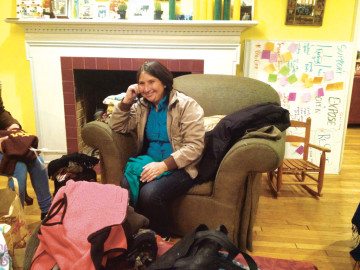
I didn’t work on Reza’s case, so I don’t know what happened that made her want to leave Honduras for the United States. I do know that cases like hers are on the rise. In 2014, border apprehensions of Central Americans outpaced those of Mexicans for the first time in more than 20 years. Nearly 69,000 families were apprehended attempting to migrate—more than triple the number in 2013, according to a U.S. Customs and Border Protection report.
Though overall immigration numbers are down, according to a Congressional Research Service report, the number of credible-fear claims in the United States nearly tripled between 2012 and 2013. Most of the claimants are from Central America.
Growing up, I always heard that immigrants came to this country “in search of better lives,” for “more opportunities.” They wanted to make money and to educate their kids, I was told. But the people in Karnes are scared. They’re running from something. And they’re not running just to the United States. According to the U.N., asylum applications to countries surrounding violence-torn El Salvador, Honduras and Guatemala increased by 712 percent between 2008 and 2013. What happened on the U.S. border last summer was not, as some have said, an immigration crisis. It was a refugee crisis.
We pulled up to Karnes County Residential Center, the 532-bed lockup that until July 2014 housed undocumented immigrant men. Since the women and kids began arriving in August, it’s been outfitted with some homey trappings. In front of the otherwise flat facade, GEO Group has built a new stucco portico and painted it institutional blue to match the new blue plastic benches beneath it and the “GEO Group, Inc.” flag that hangs next to those of the United States, Texas and the Department of Homeland Security. I did not know that private prison companies have their own flags. The GEO Group houses some 80,000 people worldwide.
Inside, we faced a long white hallway blocked by a metal detector and a receptionist whose white smock and teased hair in this context couldn’t help but evoke Nurse Ratched. Lockers to our right would store our phones and laptops. To our left, the wall was hung with prints of southwestern landscapes and informational flyers. One showed two hands reaching for each other, à la “The Creation of Adam,” and the words “Don’t let go of hope.”
The “GEO Group, Inc.” flag hangs next to those of the United States, Texas and the Department of Homeland Security. I did not know that private prison companies have their own flags.
The receptionist shook her head. “It’s been pretty steady all afternoon. People keep coming in one by one.” She sighed. “Wish it would stop. It’d be nice just to pause for a minute.”
“Oh,” Virginia said in a high, tight voice. “I’m sorry.”
The receptionist asked me to fill out a form confirming that I hadn’t been exposed to Ebola and gave me a red visitor badge in return. As Virginia listed the names and alien-registration numbers of the five women she planned to visit, ICE guards and GEO staffers passed through the metal detector. “Heading home?” the receptionist asked. “Lucky.”
“Could I call Reza first?” Virginia asked.
“Reza?”
“Yes, she’s supposed to be let out today. I’d like to see her first.”
“I don’t think we can do that. They’ll need to put her in holding.”
“Holding?”
“Yeah, the room where they wait to get let out.”
“Could I talk to her before then?”
“I don’t know if there’ll be enough time.”
“I just want to talk for 15 minutes.” It was 3:30. Reza was supposed to be let out around 5, or maybe 6.
“She might already be in holding.”
“Could you check?”
“Once she’s in holding, that’s it; she can’t come back out.”
“Yes, but could you check to see if she’s there yet?”
This conversation continued in a restrained, polite back-and-forth. Eventually the receptionist addressed the question into a walkie-talkie and received a crackled, unintelligible response. “We’ll see what we can do,” she said. We passed through the metal detector.
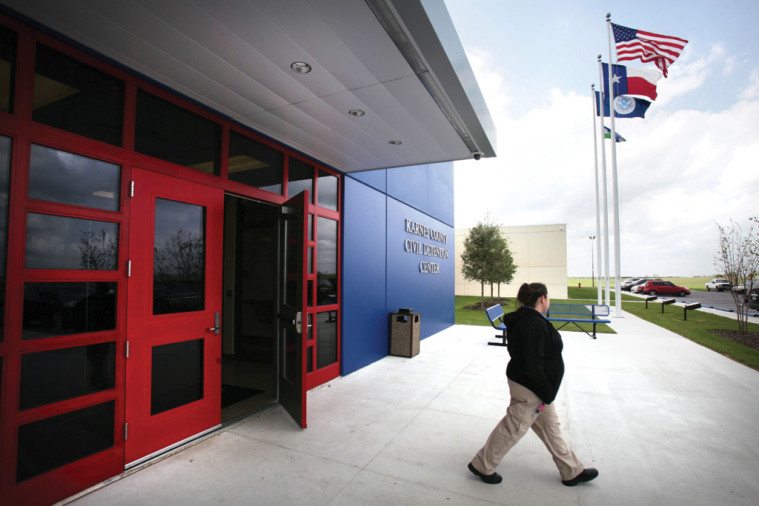
I could understand Virginia’s urge to see Reza. Karnes seemed like the sort of place where things could go wrong. Phones weren’t allowed past the metal detectors. There is no Internet access inside, and all the walkways and buzzers and antechambers separating the receptionist’s desk from the visiting area meant that communication with the outside world was difficult. Virginia had already missed a meeting with a translator of Ki’che’, a Mayan language spoken by indigenous Guatemalans. He’d sat outside the prison, waiting for her, while she’d sat inside the visitors room waiting for him.
At the end of the hallway, a woman sat behind glass in a dark room that looked like an airport control tower. Virginia waved for her to buzz us in to the visitors area and she waved back. We fiddled with a thick metal door until it opened into an antechamber barred by another metal door. I felt dizzy trying to remember the procedure for each new chamber—did I buzz, turn the door handle, smile politely and wait?
A guard let us into a big white room containing empty plastic tables and chairs. A blank flat-screen TV hung on the wall, framed by more southwestern prints. At the far end, windows opened onto three private rooms, in one of which a lawyer consulted with his clients. A guard’s desk faced another windowed room, and Virginia peered in. A few women and kids sat in chairs lined against the wall. Two of our clients were already waiting.
Many indigenous detainees speak only Mayan languages, and with the logistical obstacles and high costs involved in finding Ki’che’ interpreters, they’re often the last to receive legal assistance.
He glanced down at his binder. “She’s not on my list.”
“Oh. I wrote her name down outside.”
He shrugged. “I didn’t get it.”
Virginia wrote out Reza’s name and alien-registration number again.
The guard unlocked the waiting-room door for Olivia and Mateo [not their real names], who smiled shyly in greeting. The four of us walked through the visitors area and crowded into one of the tiny private rooms.
Olivia and Mateo would be released soon on bond, and would stay with Olivia’s friend near Amarillo while they attended to their court dates. Mateo translated our halting Spanish for his mother, a bright-eyed Guatemalan woman who spoke only Ki’che’.
This was our last meeting together. Virginia explained that their case would be transferred to Dallas, not Amarillo, because there are no immigration courts in the Panhandle. To comply with the terms of their bond, Mateo and Olivia would have to take a bus more than 350 miles to a Dallas court. Mateo didn’t understand the distance, so Virginia sketched a map of Texas on a yellow legal pad. She fussed with the drawing, trying to get the shape just right. Slowly, the distance seemed to sink in. As Mateo translated for his mother, their faces grew grim.
“Do you have any more questions?” Virginia asked.
“Can you see Diana today?” When we’d first walked in, as Virginia scanned the waiting room for Reza, we’d seen another woman sitting next to Mateo and Olivia. Diana [not her real name] had smiled hopefully behind the thick plastic window and Virginia had sighed. Like Olivia, the woman spoke only Ki’che’, and we didn’t have an interpreter with us. Many indigenous detainees speak only Mayan languages, and with the logistical obstacles and high costs involved in finding Ki’che’ interpreters, they’re often the last to receive legal assistance.
“I’m so sorry, but I don’t know how I’d speak to her,” Virginia said. Mateo and Olivia said nothing.
As parting gifts, Virginia gave Mateo and Olivia each a journal. She flipped through the pages to reveal photos of protesters shouting and waving signs. “These people were just outside,” she said. “They don’t think it’s right that you’re kept here.
“Good luck,” she added. “I hope that from now on, this country treats you better.”
I work mostly with asylum seekers, and from the months of waiting they endure, the bureaucratic inconsistencies they navigate and the callous responses of government officials to the traumatic stories they’re forced to tell again and again, it seems our immigration system is designed to discourage them, not welcome them. Once, during an asylum interview, one of our young clients told an immigration officer about the day her family was ambushed on the road by armed men. Her sister, shot in the head, had died in her lap. “But you weren’t hurt?” the officer asked brightly. “Well, weren’t you lucky!”
In the hour or so that had passed since we’d entered the visitors area, we’d seen no sign of Reza or her daughters. I walked back to the receptionist to check on them. No, I was told, we wouldn’t be able to see them before they were released. They were already in holding. “They’ll be out at 5,” the receptionist said. “Maybe 6.”
When I came back, Virginia was talking to someone new.
“I never thought we’d be in here this long,” the woman said, putting her face in her hands.

Her son was epileptic and the setting was starting to rattle him. He’d had a seizure as they crossed into the United States, and she couldn’t sleep for fear that he would have another one here.
No, she said, he hadn’t seen a doctor yet.
I was exhausted. The fluorescent lights had begun to spot the corners of my vision, and each time we left the private visitors room to call another client, more time seemed to have passed than I’d expected.
Still, I was excited to meet Maria Estela and her three daughters. I’d spent the last month talking with their cousin and aunt, who own a mom-and-pop diner in Virginia and were eager to give “the girls” a home. Vanessa, their cousin, seemed especially excited. “I’m going to be the big sister!” she told me on the phone. She wanted to teach the girls English, to help them adjust to school. But first, Vanessa noted, she’d teach them to cook the very first American-style food she’d learned to make: Mickey Mouse pancakes. Vanessa and her mom had already started buying school supplies and winter clothes. She sent me page after page of documents to show a judge that she and her mom were fit to house them. Most people send me tax returns and utility bills. Vanessa added her babysitting certificate and a good-behavior report from middle school. She even put together a statement from the diner customers welcoming the girls to town.
The girls came out of the waiting room in matching pink Converse shoes. Melissa, the oldest, held pages torn from a legal pad in her hands. I wanted to compliment their shoes—they hinted at a kind of sassy, sisterly solidarity, I thought—but something in their faces stopped me. I’m not sure what I was expecting from them—some familial trace of Vanessa’s bounciness, I suppose. It wasn’t there, at least not today.
Virginia noticed too. Maria Estela hugged Jackeline, the littlest, in her lap. Melissa and Carmen, 15 and 13, sat with their arms crossed, staring at their laps. “Why does everyone look so sad?” Virginia asked.
Maria Estela smiled apologetically. “Our story. Melissa wrote it just before you got here. It’s upset her.”
“Oh Melissa,” Virginia said, getting up to wrap her arms around the teenage girl. That was the tipping point; Melissa’s tears came down fast.
“Do you want me to read it now?” Virginia asked. Melissa nodded. The room was quiet as Virginia scanned the pages. She’d asked Melissa to write down why they’d left El Salvador for the United States. Virginia wanted to make their story public.
Maria Estela’s situation was tricky. She’d been deported once before for trying to enter the United States. This time, she and her daughters had fled their town after two MS-13 gang members broke into their home and put a gun to Maria Estela’s head, attempting to collect an extortion she couldn’t pay. I read about this later, the scene recorded by Melissa in her careful, looping script.
In the six months since Karnes has been open to families, MALDEF, Human Rights First and other legal groups have filed complaints alleging sexual abuse, extortion and harassment of the women and children detained there.
Maria Estela could pay them, he said, or she could give them her daughters as MS-13 girlfriends, who are often raped as part of the gang’s initiation. “That would be the best payment,” he said.
If they didn’t like those options, the other added, the extortionists could rape and kill them all right then.
“Yes,” Maria Estela said, agreeing to give them her daughters. “Yes, that’s fine.”
The men said they’d come back. Maria Estela and the girls left before they could make good on the threat. Despite this story, the ICE official who interviewed them determined that Maria Estela did not possess a “reasonable fear” of returning to El Salvador, which, according to the United Nations, has the highest rate of femicide in the world.
Virginia stopped reading. “This is very difficult,” she said to Melissa. “May I read the rest later?”
Melissa nodded and again the room fell silent. “How is everything else?” Virginia asked.
Jackeline wriggled in her mother’s arms. “She’s cold,” Maria Estela said. “We’re all cold.” They each wore a sweatshirt, but I could see why that wouldn’t be enough in a semi-heated building surrounded by 40-degree November weather; I was wearing my winter coat and I didn’t feel warm, either. Maria Estela had heard that if they were released, their sweatshirts would be taken from them. “They say they’re loans, that they’re not ours to keep.”
“Some people have to leave this place almost naked,” Melissa said, wide-eyed.
“Well,” Virginia said, “I was going to give you this.” She pulled off her sweater, a blue and black knit from Ann Taylor, and handed it to Jackeline. “Here you go.” The sweater hung huge on the little girl, who tucked her knees up into it. I offered my thin cardigan and Virginia added her red puffy vest. Melissa and Carmen swapped sweaters to better match the clothes they were wearing. They wanted to look as if they hadn’t just received new clothes, so the guards wouldn’t confiscate them.
Stories of such small cruelties are common to Karnes. There are more serious allegations, too. In the six months since Karnes has been open to families, MALDEF, Human Rights First and other legal groups have filed complaints alleging sexual abuse, extortion and harassment of the women and children detained there. Similar complaints surfaced at the T. Don Hutto Family Residential Center in Taylor, which forced that facility to stop holding migrant families in 2010. For four years, Texas had been free of family detention centers, but family detention is back. In December 2014, a new private detention facility opened in Dilley, southwest of San Antonio. Built to house 2,400 people, it is by far the largest family detention center in the country.
 I can’t remember why I left the visiting area again. Virginia asked me to call someone, or put something in our locker, or maybe I just needed to use the bathroom.
I can’t remember why I left the visiting area again. Virginia asked me to call someone, or put something in our locker, or maybe I just needed to use the bathroom.
Nurse Ratched must have heard my footsteps down the hallway, because she turned to me and shouted, “Hey! Tell your friend they’re letting them out.”
“Now?” I froze.
“Yeah, right now. Y’all need to get out here quick.”
I buzzed and tapped until the guard let me back in. Virginia was talking with two new people. I opened the door.
“Virginia, they’re letting them out.”
“When?”
“Right now, actually. Sorry. The receptionist says we should get out there.”
I had no idea what time it was. Without my cellphone to use as a watch, time seemed to have sped up in the white, clockless room.
“I’m so sorry,” Virginia said to her two clients, “but they’re telling me I have to go. Do you know Reza? Dalia? Julie? They’re being released right now.”
We hurried to the exit. The guard didn’t look up from his binder. I buzzed; no response. I buzzed again. The door wouldn’t open. “Excuse me?” I said to the guard. “Do I buzz?” He sighed, closed his binder, and got up to open the door.
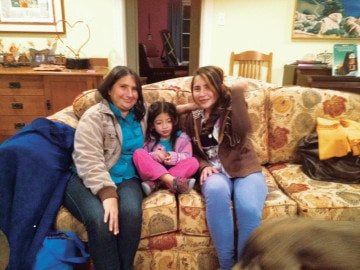
We walked into the hallway just as another door opened to reveal a small group of women and girls flanked by guards. I smiled at them, searching their faces. I’d never met Reza; was it her? Virginia walked ahead of everyone, hell-bent for the receptionist’s desk.
“Virginia?”
She turned around. “Oh!”
“Abogada!” A high, young voice bounced off the white walls. A tiny girl sprinted from a tangle of taller legs, her long brown hair flapping behind her like a banner. Her mouth was wide open and bright red, as if she’d just swallowed a huge piece of candy. “Abogada!”
This was Dalia, a friend to prison guards and pro bono attorneys alike, a 6-year-old who would lie in wait for Virginia under the tables and chairs of Karnes’ visitors room and leap out to shriek “Boo!” She’d grown skinny at Karnes, her mother later told us, echoing other parents’ claims. Dalia wouldn’t eat in there. The food was spiced too heavily for a 6-year-old. The meat tasted rancid.
We stepped easily through the metal detector. We hugged and laughed. We returned our visitors badges, gathered our IDs, and pulled our laptops from the lockers. The detached half-smile I’d worn through all the buzzing and the chambers and the walkways no longer felt necessary. It melted away, replaced by a confusing surge of elation and then dismay. Because this is how our country treats refugees.
The reception area was full. Pastor Rosemarie Doucette of San Antonio’s Good News Lutheran Church was there to pick up the other women who’d been let out along with Reza’s family. This was her first time at Karnes, too, but she’d done this before, in the 1980s, when civil wars and genocide sent nearly 1 million Central Americans to the U.S. border seeking asylum. At the time, Rosemarie had been part of the Sanctuary Movement of religious and political groups that offered safe haven to refugees, sometimes in defiance of government deportation orders. She’d lived in Chicago then, and she remembers how the kids staying at her church would go nuts at their first sight of snow. “Go on,” she’d say, nudging them outside. “You can eat it.” She’d recently become involved again, in what some are calling the New Sanctuary Movement. On her drive to Karnes, she said, she’d repeated a Bible verse to herself: “The prisoner is soon to be set free.”
I watched Julie, 15, a quieter counterpart to her little sister. She wore skinny jeans and a brown hoodie. Her wrists were wrapped in friendship bracelets she’d learned to weave from the Salvadoran kids she’d met in Karnes. Julie smiled shyly at everyone, but mostly stared at the floor. When she looked up, it was toward the prison’s glass doors. It was now past 6 p.m., and there was nothing to see beyond them but blackness tinged by fluorescent light. She put her hand to her mouth and her face crumpled. She reached for her mom, and for a few moments the two of them stood there watching those doors.
“Our friends,” Reza said, looking back down the hall. “What will happen to them?”
“Listas?” Virginia said. “Ready?” She opened the door.
The wind whipped across the flat black parking lot. In the distance, fracking flames glowed under a half moon. It was dark and cold and there wasn’t much to see. But for me, a night has never felt more wild. Virginia let out a loud whoop, and then we all did. We raised our fists and howled into that cold night, walking toward Virginia’s car, feeling like the wildest, freest creatures on earth.
